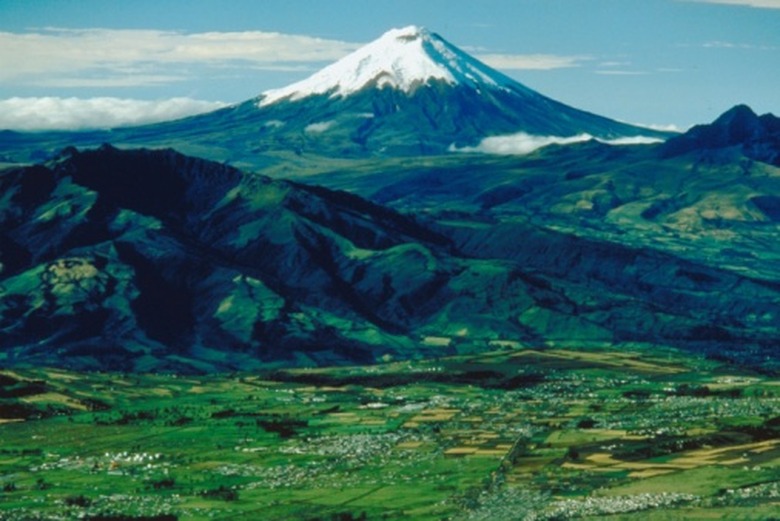The Difference Between An Earthquake & A Volcano
Earthquakes and volcanoes are both a result of plate tectonics. The Earth's surface is covered with a series of crustal plates that move in response to convection currents, produced by heat from the mantle and core. Geologists have concluded the formation of the various continents is a result of the movement of these various plates. Where and when these plates meet dictates the location and occurrence of volcanoes and earthquakes, respectively.
Plate Boundaries
Plate Boundaries
There are three types of plate boundary; convergent, divergent and transform. According to the Classroom of the Future website, convergent boundaries occur when two tectonic plates meet each other directly and crush or crunch together. Divergent boundaries are formed when two plates move apart. Transform boundaries occur when two plates slide past each other, such as along the San Andreas Fault in California.
Volcanoes
Volcanoes
Volcanoes only occur at convergent and divergent plate boundaries. At convergent boundaries, one plate is forced below the other, forming a ridge along which mountains and volcanoes develop. Huge forces are exerted as the plates meet. This causes cracks to occur in the crust, which are filled by magma escaping from the mantle, ultimately producing a volcano, as described by BBC Bitesize. In contrast, the plates moving in opposite directions at divergent boundaries cause the crust to break apart, leaving a gap. This gap is filled by magma, forming new crust at the boundary, according to Classroom of the Future. Volcanoes are formed where this magma reaches the surface. When pressure within volcanoes builds up to a certain level, they erupt, spewing molten magma and debris over the surrounding areas.
Earthquakes
Earthquakes
According to an article by BBC News in 2009, earthquakes are among the most destructive natural events. Earthquakes are not a geological structure like volcanoes and they do not release magma. They are violent movements of the Earth's crust. However, unlike volcanoes, earthquakes are common to all types of plate boundary. Earthquakes occur as a result of friction and build up of pressure between plates. They can take place when moving plates collide or when they become locked together. At transform boundaries, for example, plates moving side by side may become locked together, and the pressure (potential energy) will build up. Eventually the plates break free, releasing the stored energy in the form of an earthquake.
Prediction
Prediction
Scientists have achieved more success predicting the occurrence of volcanoes compared to earthquakes, which are extremely difficult to predict. The reason why earthquakes are so difficult to predict is due to the lack of regular patterns in their occurrence, according to Randy Kobes and Gabor Kunstatter at the University of Winnipeg physics department. This makes earthquakes a greater risk to humans. Moreover, earthquakes often occur in densely populated regions, such as along the San Andreas fault, whereas there tends to be lower population densities in the vicinity of volcanoes. This is due to volcanoes often being synonymous with mountainous terrain, which is not suited for settlements. However, there are some exceptions to this, such as Mt. St. Helen's, which is located within a heavily populated area of the United States.
Cite This Article
MLA
Newton, John. "The Difference Between An Earthquake & A Volcano" sciencing.com, https://www.sciencing.com/difference-between-earthquake-volcano-8542814/. 24 April 2017.
APA
Newton, John. (2017, April 24). The Difference Between An Earthquake & A Volcano. sciencing.com. Retrieved from https://www.sciencing.com/difference-between-earthquake-volcano-8542814/
Chicago
Newton, John. The Difference Between An Earthquake & A Volcano last modified March 24, 2022. https://www.sciencing.com/difference-between-earthquake-volcano-8542814/
